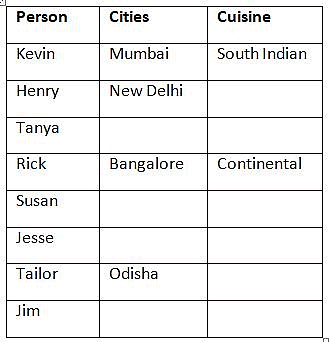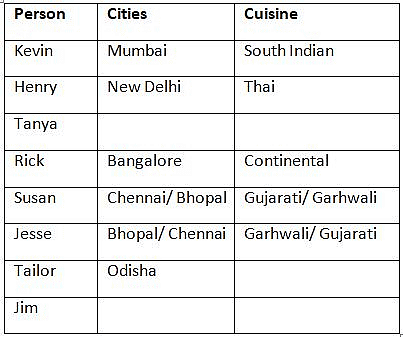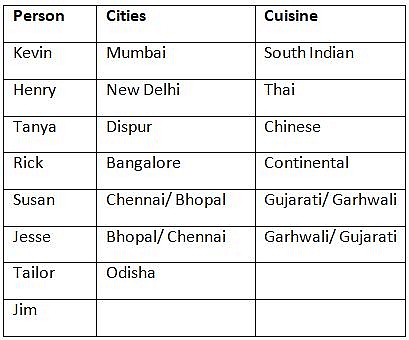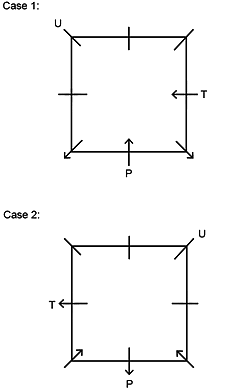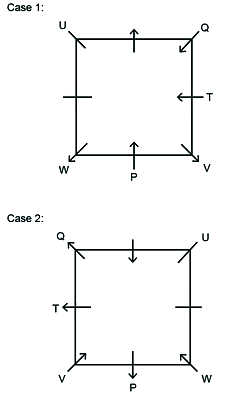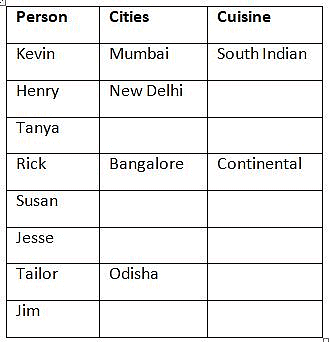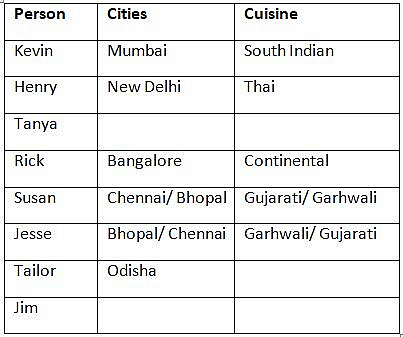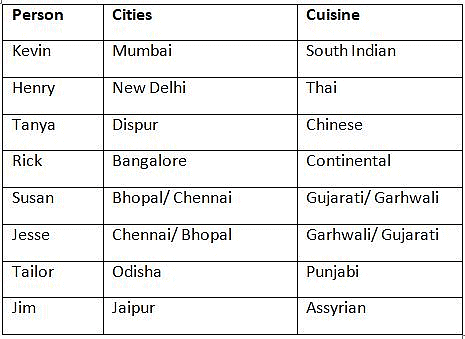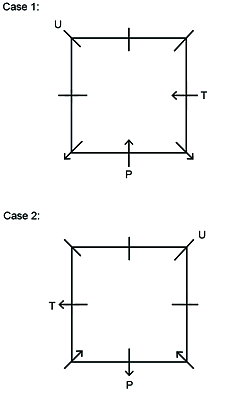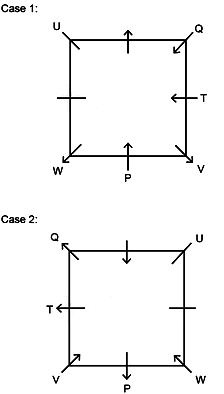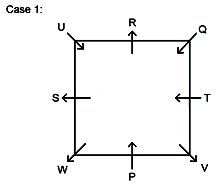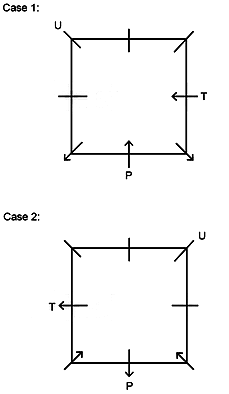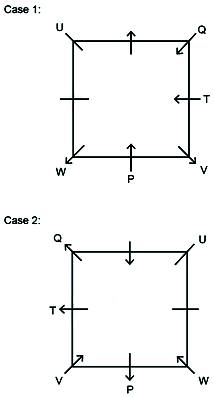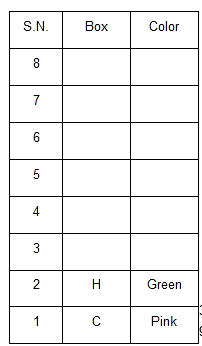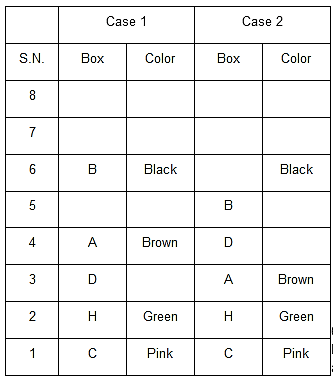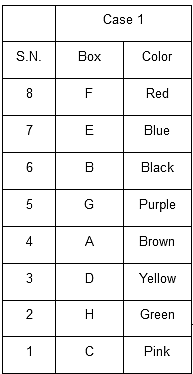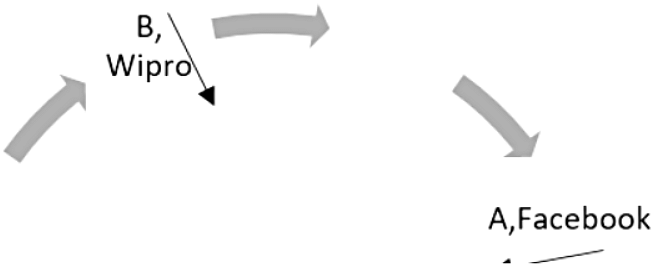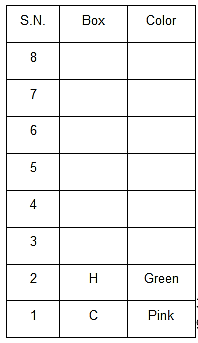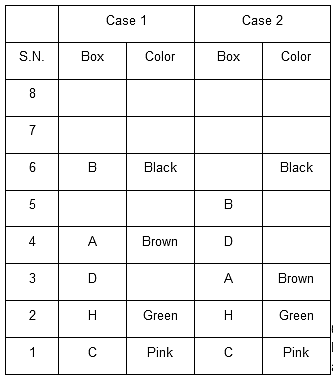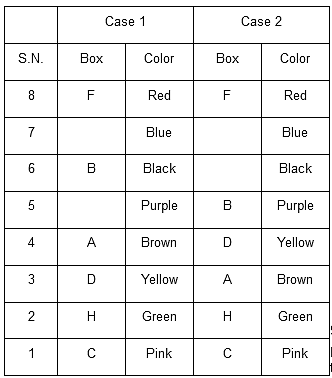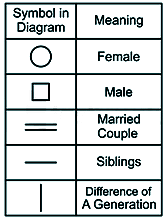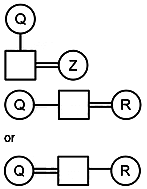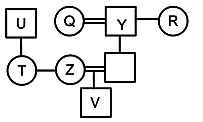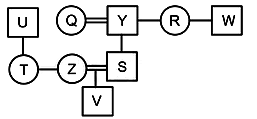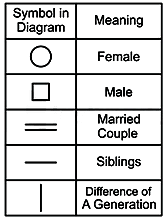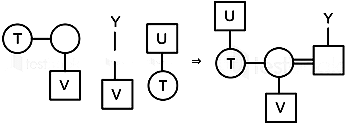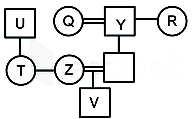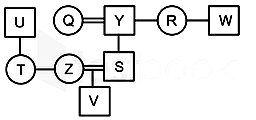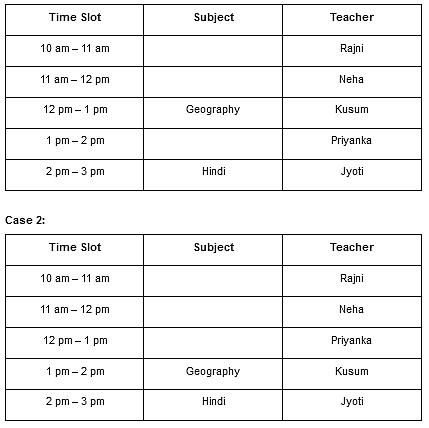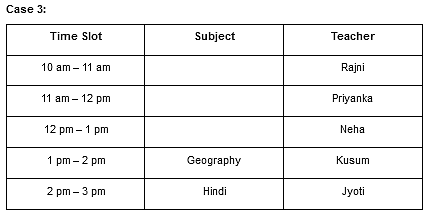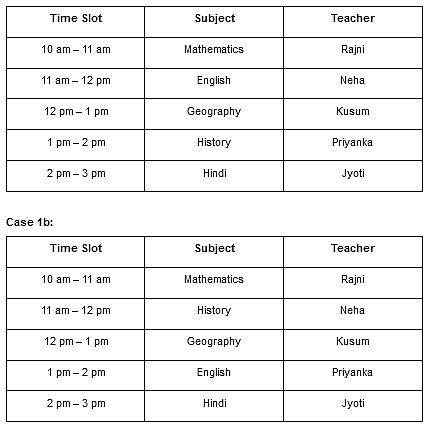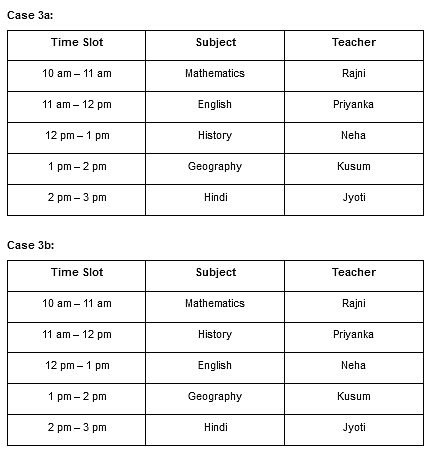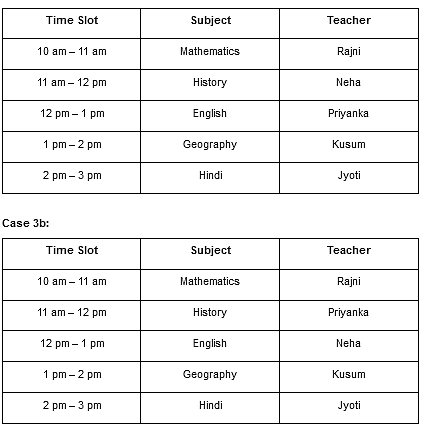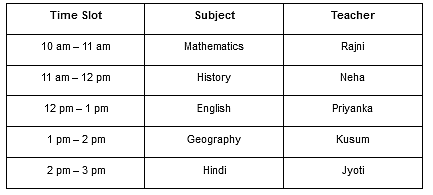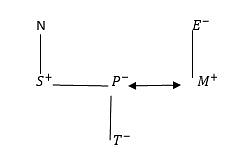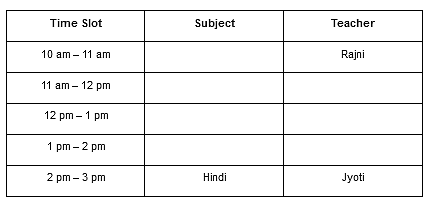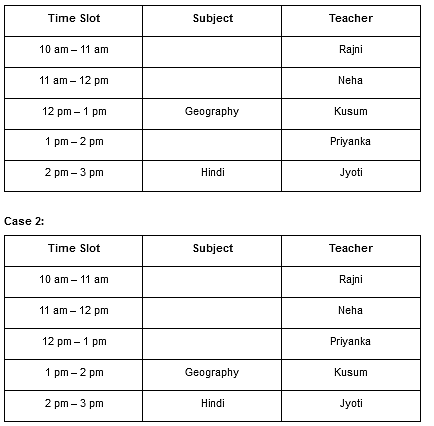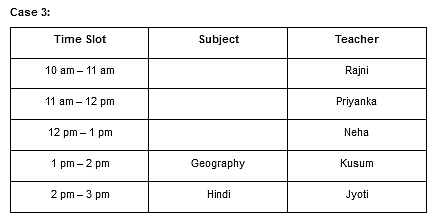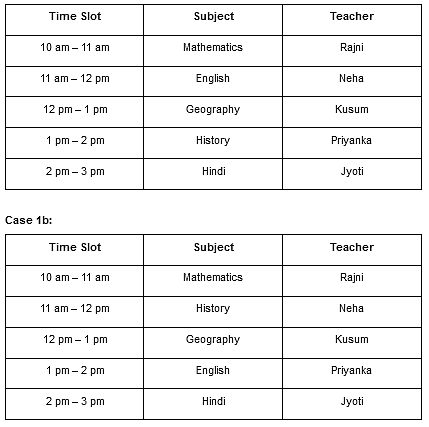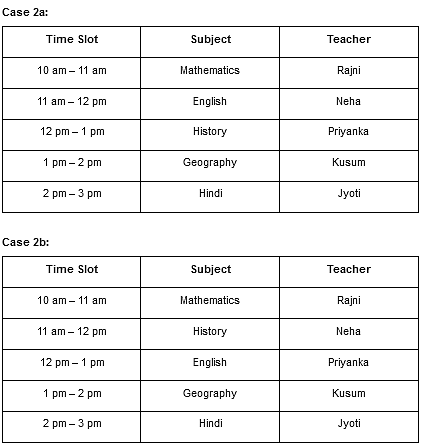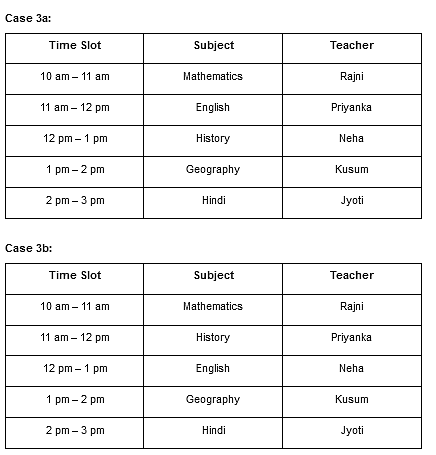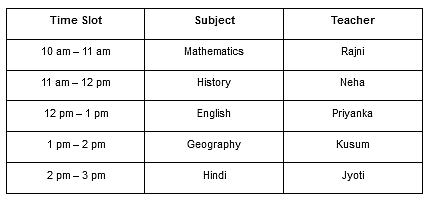NABARD Assistant Manager Grade 'A' Mock Test - 3 - Bank Exams MCQ
30 Questions MCQ Test NABARD Assistant Manager Grade A Mock Test Series 2024 - NABARD Assistant Manager Grade 'A' Mock Test - 3
If it is possible to make only one meaningful English word with the 2nd, 4th,5thand 8th letters of the word PRONUNCIATION, which of the following will be the second letter of that word? If no such word can be made give ‘X’ as the answer and if more than one such word can be made give ‘Y’ as the answer.
Study the following information carefully and answer the questions given below:
Kevin, Henry, Tanya, Rick, Susan, Jesse, Tailor, and Jim are eight persons. Each of them visits different cities, which are Dispur, Bangalore, Mumbai, New Delhi, Bhopal, Odisha, Chennai, and Jaipur. Each of them has a different choice of cuisine-Assyrian, Gujarati, Punjabi, Chinese, Thai, Garhwali, South Indian, and Continental but not necessarily in the same order.
(i) Kevin, who likes South Indian, visits neither Jaipur nor Bhopal.
(ii) Henry visits New Delhi and does not like either Assyrian or Punjabi.
(iii)The one who visits Dispur likes Chinese.
(iv) The one who likes Continental visits Bangalore and the one who visits Chennai likes Gujarati.
(v) Jim doesn’t like Thai.
(vi) Susan and Jesse like Gujarati and Garhwali, though not necessarily in the same order.
(vii) Rick likes Continental.
(viii) Tailor visits Odisha and doesn’t like Assyrian.
(ix)The one who visits Bhopal likes Garhwali.
(x) Tanya doesn’t visit Jaipur.
(xi) The one who visits Mumbai doesn’t like either Punjabi or Thai. Q. Tanya visits which of the following cities?
Direction: Study the following information to answer the given questions:
Eight cars P, Q, R, S, T, U, V and W are parked around the square parking area. Four cars are parked on the corners while four are parked on the middle of the sides. Equal number of cars face towards and away from the center. Not more than two adjacent cars face in the same direction.
Car P is not opposite to car S. Car T is second to the right of car P and both face in same direction. Car V is not adjacent to car U. Two cars are parked between car T and car U, which is parked on the corner. Car Q is opposite to car W. Car P and car U are not adjacent to each other. Car Q and car T face in same direction. Immediate neighbours of car P face in same direction. Car S does not face towards the center. Car U and car R are immediate left of each other.
Q. Which car is parked second to the left of car P?
Study the following information carefully and answer the questions given below:
Kevin, Henry, Tanya, Rick, Susan, Jesse, Tailor, and Jim are eight persons. Each of them visits different cities, which are Dispur, Bangalore, Mumbai, New Delhi, Bhopal, Odisha, Chennai, and Jaipur. Each of them has a different choice of cuisine-Assyrian, Gujarati, Punjabi, Chinese, Thai, Garhwali, South Indian, and Continental but not necessarily in the same order.
(i) Kevin, who likes South Indian, visits neither Jaipur nor Bhopal.
(ii) Henry visits New Delhi and does not like either Assyrian or Punjabi.
(iii)The one who visits Dispur likes Chinese.
(iv) The one who likes Continental visits Bangalore and the one who visits Chennai likes Gujarati.
(v) Jim doesn’t like Thai.
(vi) Susan and Jesse like Gujarati and Garhwali, though not necessarily in the same order.
(vii) Rick likes Continental.
(viii) Tailor visits Odisha and doesn’t like Assyrian.
(ix)The one who visits Bhopal likes Garhwali.
(x) Tanya doesn’t visit Jaipur.
(xi) The one who visits Mumbai doesn’t like either Punjabi or Thai.
Q. Which of the following cuisine Tanya likes?
Direction: Study the following information to answer the given questions:
Eight cars P, Q, R, S, T, U, V and W are parked around the square parking area. Four cars are parked on the corners while four are parked on the middle of the sides. Equal number of cars face towards and away from the center. Not more than two adjacent cars face in the same direction.
Car P is not opposite to car S. Car T is second to the right of car P and both face in same direction. Car V is not adjacent to car U. Two cars are parked between car T and car U, which is parked on the corner. Car Q is opposite to car W. Car P and car U are not adjacent to each other. Car Q and car T face in same direction. Immediate neighbours of car P face in same direction. Car S does not face towards the center. Car U and car R are immediate left of each other.
Q. Car U is opposite to car ______.
In each of the questions below are given some statements followed by some Conclusions. You have to take the given statements to be true even, if they seem to be at variance from commonly known facts. Read all the conclusions and then decide which of the given conclusions logically follows from the given statements disregarding commonly known facts.
Statements:
Only a few Ribbons are Candles
Some Candle are Layers
No Sweet is a Layer
All Sweets are Tastes
Conclusions:
I) Some Layers are not Ribbons
II) No Candle is a Sweet
III) Some Tastes are not Layers
Direction: Study the following information to answer the given questions:
Eight cars P, Q, R, S, T, U, V and W are parked around the square parking area. Four cars are parked on the corners while four are parked on the middle of the sides. Equal number of cars face towards and away from the center. Not more than two adjacent cars face in the same direction.
Car P is not opposite to car S. Car T is second to the right of car P and both face in same direction. Car V is not adjacent to car U. Two cars are parked between car T and car U, which is parked on the corner. Car Q is opposite to car W. Car P and car U are not adjacent to each other. Car Q and car T face in same direction. Immediate neighbours of car P face in same direction. Car S does not face towards the center. Car U and car R are immediate left of each other.
Q. Which car is third to the right of car Q?
In each of the questions below are given some statements followed by some Conclusions. You have to take the given statements to be true even, if they seem to be at variance from commonly known facts. Read all the conclusions and then decide which of the given conclusions logically follows from the given statements disregarding commonly known facts.
Statements:
Some Values are Traditions
All Traditions are Customs
Only Cultures are Castes
No caste is a Custom
Conclusions:
I) No Culture is a Custom
II) Some Customs are Values
III) Some Customs are Cultures
Direction: Study the following information carefully and answer the questions given below.
8 boxes – A, B, C, D, E, F, G and H which are of different color Blue, Black, Green, Yellow, Purple, Pink, Red, and Brown arranged from bottom to top but not necessarily in the same order.
Box F is placed immediately above the blue color of the box. Three boxes are placed between the black color and green color of the box. Box H which is of green color is placed immediately above C. Number of boxes above the box B is the same as the number of boxes below box D. Box A which is of brown color is placed 2 boxes below box B. Box C which is of pink color placed on bottom-most position. Only one box is placed between the blue color of the box and the purple color of the box which is placed below blue box. Neither box B nor F is the purple color of the box. Box G is placed below box E. The red color of the box is placed above the yellow color of the box.
Q. How many boxes are there between Red color box and Pink box?
Study the following information carefully and answer the given question.
Eight-person A,B ,C ,D ,E, F, G and H are sitting around a circular table in a meeting. Some are facing the centre while some are facing outside the centre. They also work in different companies viz. Wipro, Glenmark, Google, Bank of America, Infosys, IBM, Yahoo and Facebook.
A sits third to the right of C. There is one person sitting between A and B. D sits fourth to right of B. The person who works with Google sits second to the right of D. A does not work with Google. Three persons sit between the person who works with Google and Facebook. The person who works with Wipro sits second to the right of the person who works with Facebook. D does not work with Wipro. The person who work with IBM sits third to the right of the person who work with Wipro. C work with IBM. There are two people sitting between D and E. There are three people sitting between the person who work with Infosys and Bank of America. E does not work with Infosys or Bank of America. There is one person sitting between the person who work with Bank of America and Glenmark. The person who work with Google sits third to the right of the person who work with Glenmark. The person who work with Yahoo sits third to the right of the person who work with Bank of America. G sits fourth to right of the person who work with Infosys. F is not the immediate neighbour of G. The person who work with Infosys sits third to the left of the person who work with Google and both faces the same direction.(Same direction means if one faces centre then other also faces the centre and vice-versa). E faces opposite the centre. A work with Facebook.
Q. Which of the following is correctly matched?
Direction: Study the following information carefully and answer the questions given below.
8 boxes – A, B, C, D, E, F, G and H which are of different color Blue, Black, Green, Yellow, Purple, Pink, Red, and Brown arranged from bottom to top but not necessarily in the same order.
Box F is placed immediately above the blue color of the box. Three boxes are placed between the black color and green color of the box. Box H which is of green color is placed immediately above C. Number of boxes above the box B is the same as the number of boxes below box D. Box A which is of brown color is placed 2 boxes below box B. Box C which is of pink color placed on bottom-most position. Only one box is placed between the blue color of the box and the purple color of the box which is placed below blue box. Neither box B nor F is the purple color of the box. Box G is placed below box E. The red color of the box is placed above the yellow color of the box.
Q. Which box is placed immediate below box E?
Study the following information carefully and answer the given question.
Eight-person A, B, C, D, E, F, G and H are sitting around a circular table in a meeting. Some are facing the centre while some are facing outside the centre. They also work in different companies viz. Wipro, Glenmark, Google, Bank of America, Infosys, IBM, Yahoo and Facebook.
A sits third to the right of C. There is one person sitting between A and B. D sits fourth to right of B. The person who works with Google sits second to the right of D. A does not work with Google. Three persons sit between the person who works with Google and Facebook. The person who works with Wipro sits second to the right of the person who works with Facebook. D does not work with Wipro. The person who work with IBM sits third to the right of the person who work with Wipro. C work with IBM. There are two people sitting between D and E. There are three people sitting between the person who work with Infosys and Bank of America. E does not work with Infosys or Bank of America. There is one person sitting between the person who work with Bank of America and Glenmark. The person who work with Google sits third to the right of the person who work with Glenmark. The person who work with Yahoo sits third to the right of the person who work with Bank of America. G sits fourth to right of the person who work with Infosys. F is not the immediate neighbour of G. The person who work with Infosys sits third to the left of the person who work with Google and both faces the same direction.(Same direction means if one faces centre then other also faces the centre and vice-versa). E faces opposite the centre. A work with Facebook.
Q. If E is related to C and B is related to D, in the same way, A is related to?
Directions: Study the given information carefully and answer the following questions:
In a family of 9 members i.e. Q, R, S, T, U, V, W, Y and Z there are three generations and two married couples. R is sister of W who is unmarried man. Q has no sister. Z is the daughter-in-law of Q, who is the sister-in-law of R. S is the nephew of R. Y has only one child. T is the maternal aunt of V who is grandson of Y. U is father of T.
Q. How is S related to T?
In each question, relationship between different elements is shown in the statements. The statements are followed by conclusions. Study the conclusions based on the given statement and select the appropriate answer. Give answer
Statements: P < Q = S ? U; V ? P ? N > I
Conclusions: I. U < V II. Q > I
Directions: Study the given information carefully and answer the following questions:
In a family of 9 members i.e. Q, R, S, T, U, V, W, Y and Z there are three generations and two married couples. R is sister of W who is unmarried man. Q has no sister. Z is the daughter-in-law of Q, who is the sister-in-law of R. S is the nephew of R. Y has only one child. T is the maternal aunt of V who is grandson of Y. U is father of T.
Q. Which of the following statements is true according to the given passage?
I. V is the grandson of T.
II. U is maternal grandfather of V.
III. R is paternal aunt of V.
In each question, relationship between different elements is shown in the statements. The statements are followed by conclusions. Study the conclusions based on the given statement and select the appropriate answer. Give answer
Statements: J < K = L ? M ? P; F ? K < G
Conclusion I. J < G II.F ? P
Directions: Study the following information and answer the below questions.
Five teachers teach different subjects viz. Hindi, English, Mathematics, Geography, History, but not necessarily in the same order, in the different time slots of 1 hour from 10 am to 3 pm. The teachers are Jyoti, Kusum, Rajni, Neha, and Priyanka but not necessarily in the same order. Each teacher teaches different subjects. No teacher teaches more than one subject.
Neha does not take the class of Geography. The one who takes the class of Hindi takes the last lecture. Neither Rajni nor Priyanka takes the class of Hindi. Kusum takes the class of Geography but after Neha. Mathematics class is scheduled before English but not in the slot of 11-12 pm. Kusum takes her class exactly between the class taken by Jyoti and class of English. Only one class is scheduled between the Class of Mathematics and the Class of English. Also, only one is class is scheduled between Class of History and class of Geography. Three classes are scheduled between Class of Jyoti and Class of Rajni who does not take the class of Hindi. Priyanka does not take the class of History.
Q. Who takes the class which is scheduled immediately after the class of Mathematics?
Study the following information carefully and answer the questions given below:
S is brother of P. N is mother of S. T is daughter of P. E is grandmother of T. N does not have married son.
Q. If M is married to P, then how is S related to M?
Directions: Study the following information and answer the below questions.
Five teachers teach different subjects viz. Hindi, English, Mathematics, Geography, History, but not necessarily in the same order, in the different time slots of 1 hour from 10 am to 3 pm. The teachers are Jyoti, Kusum, Rajni, Neha, and Priyanka but not necessarily in the same order. Each teacher teaches different subjects. No teacher teaches more than one subject.
Neha does not take the class of Geography. The one who takes the class of Hindi takes the last lecture. Neither Rajni nor Priyanka takes the class of Hindi. Kusum takes the class of Geography but after Neha. Mathematics class is scheduled before English but not in the slot of 11-12 pm. Kusum takes her class exactly between the class taken by Jyoti and class of English. Only one class is scheduled between the Class of Mathematics and the Class of English. Also, only one is class is scheduled between Class of History and class of Geography. Three classes are scheduled between Class of Jyoti and Class of Rajni who does not take the class of Hindi. Priyanka does not take the class of History.
Q. In which of the following time slots, is the class of History scheduled?
Read the following information carefully and answer the given questions.
P, Q, R, S, T and U are six friends. Each of them has different weights. Q is heavier than only R. T is lighter than only two people. U is not the heaviest. The difference between the weights of second heaviest and the third lightest person is 7 kg. P is heavier than T but is not the heaviest. The weight of P is 82 kg.
Q. What could be the possible Weight of T?
Directions: Read the passage given below and answer the questions that follow by choosing the correct/most appropriate options:
The struggle to achieve gender equality and bridge the gap between men and women is a long and difficult one. India has got another opportunity to do much better for half of its population with the Global Gender Gap Index for 2022, released by the World Economic Forum on Wednesday, placing it at 135 out of 146 countries. But the new data — India’s ranking in 2021 was 140 out of 156 countries — hardly brings cheer as India has fared the worst in at least one of the parameters — ‘health and survival’ — in which it took the last spot. The Global Gender Gap Index benchmarks the current state and evolution of gender parity across four dimensions: economic participation and opportunity; educational attainment; health and survival, and political empowerment. India ranks poorly among its neighbours and is behind Bangladesh, Nepal, Sri Lanka, the Maldives and Bhutan. Only Iran, Pakistan and Afghanistan perform worse than India in the region. In 2022, coming on the back of a pandemic, war and economic crises, the global gender gap has been closed by 68.1%, which means at the current rate of progress it will take 132 years to reach full parity. Among all the regions, it will take the longest for South Asia to reach the target — 197 years — “due to a broad stagnation in gender parity scores ... in the region”.
There have been enough numbers from the ground to indicate that India, with a female population of approximately 66 crores, has faltered on the road to gender parity. In the pandemic years, as incomes shrank, women faced hurdles on every front, from food, health, and education for the girl child to jobs. The latest NFHS data (2019-2021) show that 57% of women (15-49 age bracket) are anaemic, up from 53% in 2015-16; though 88.7% of married women participate in key household decisions, only 25.4% of women, aged 15-49 years, who worked in the last 12 months (2019-2021), were paid in cash. Women having a bank account or savings account that they themselves use have increased to 78.6%, with schemes such as the Pradhan Mantri Jan Dhan Yojana helping, but women's participation in the labour force has shrunk. According to Centre for Monitoring Indian Economy (CMIE) data, in 2016-17 about 15% of women were employed or looking for jobs; this metric dipped to 9.2% in 2021-22. The best way to improve India’s abysmal ranking is to do it right by women. For that, it is imperative to increase the representation of women in leadership positions at all levels so that women get greater access to jobs and resources. It is up to the Government to move beyond tokenism and help women overcome staggering economic and social barriers.
Q. According to the passage, how Indian women will get greater access to jobs and resources?
Who is set to receive the Lifetime Achievement Award at the BCCI Awards?
Which fruit holds the title of the biggest fruit in the world as of January 2024?
Which company has received approval from the Odisha government for its Rs 40,000 Crore electric vehicle (EV) venture?
From 2026 onwards, which city will host the Spanish Formula 1 Grand Prix?
What percentage of financial assistance is provided for the capital cost of solar rooftop projects under the National Rooftop Solar Scheme?
Which countries are participating in the 2nd edition of Exercise CYCLONE?
When is Parakram Diwas observed?
Who led the main rituals of the much-awaited consecration ceremony of Shri Ram Lalla in Ayodhya?
Who is the chief architect of the construction of Ayodhya Ram temple?
|
14 docs|63 tests
|


